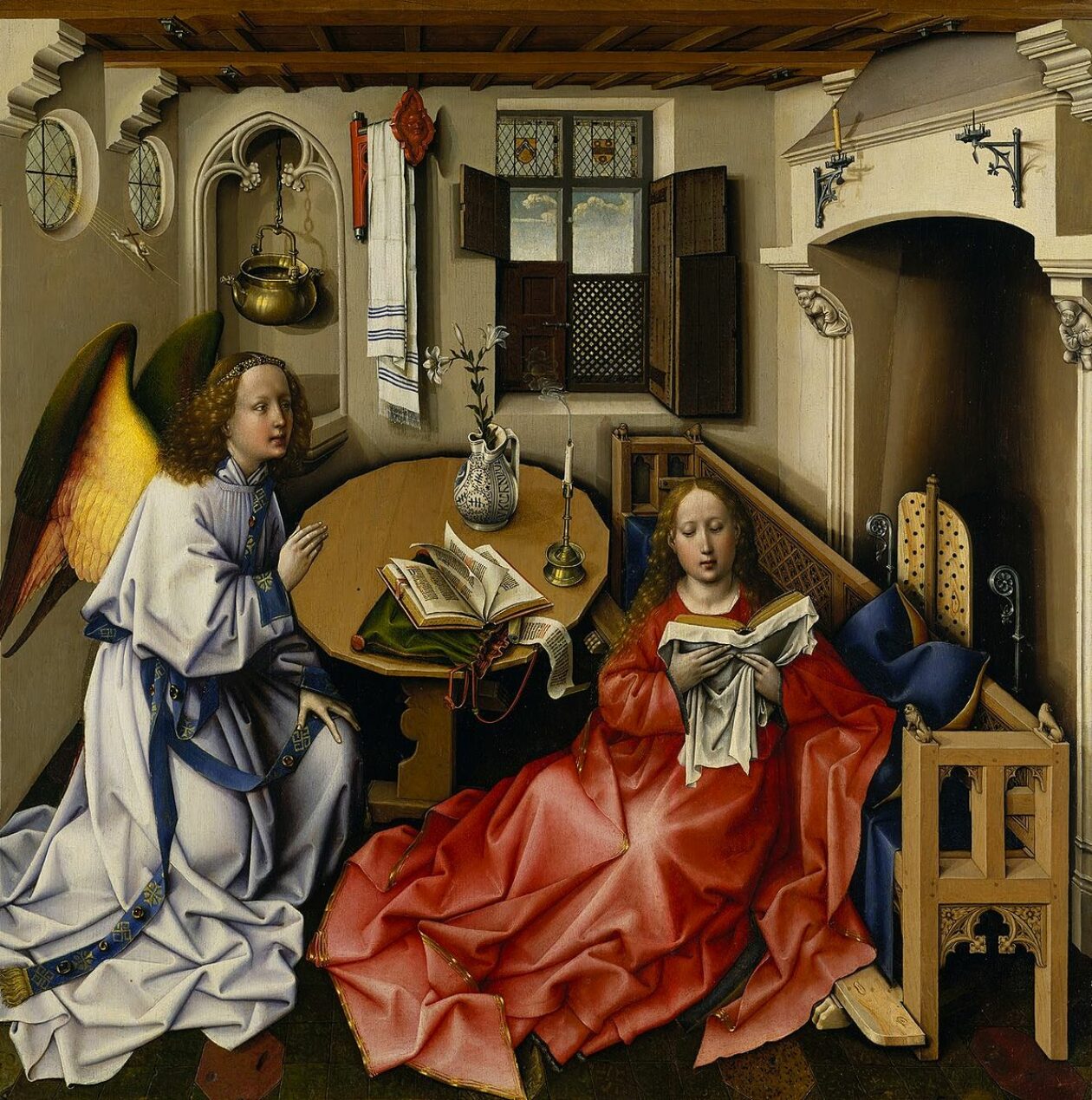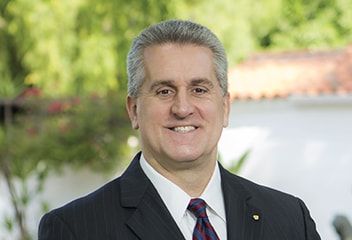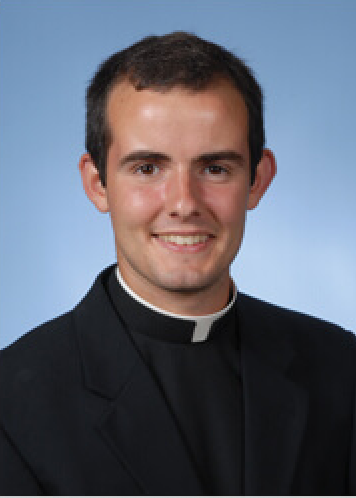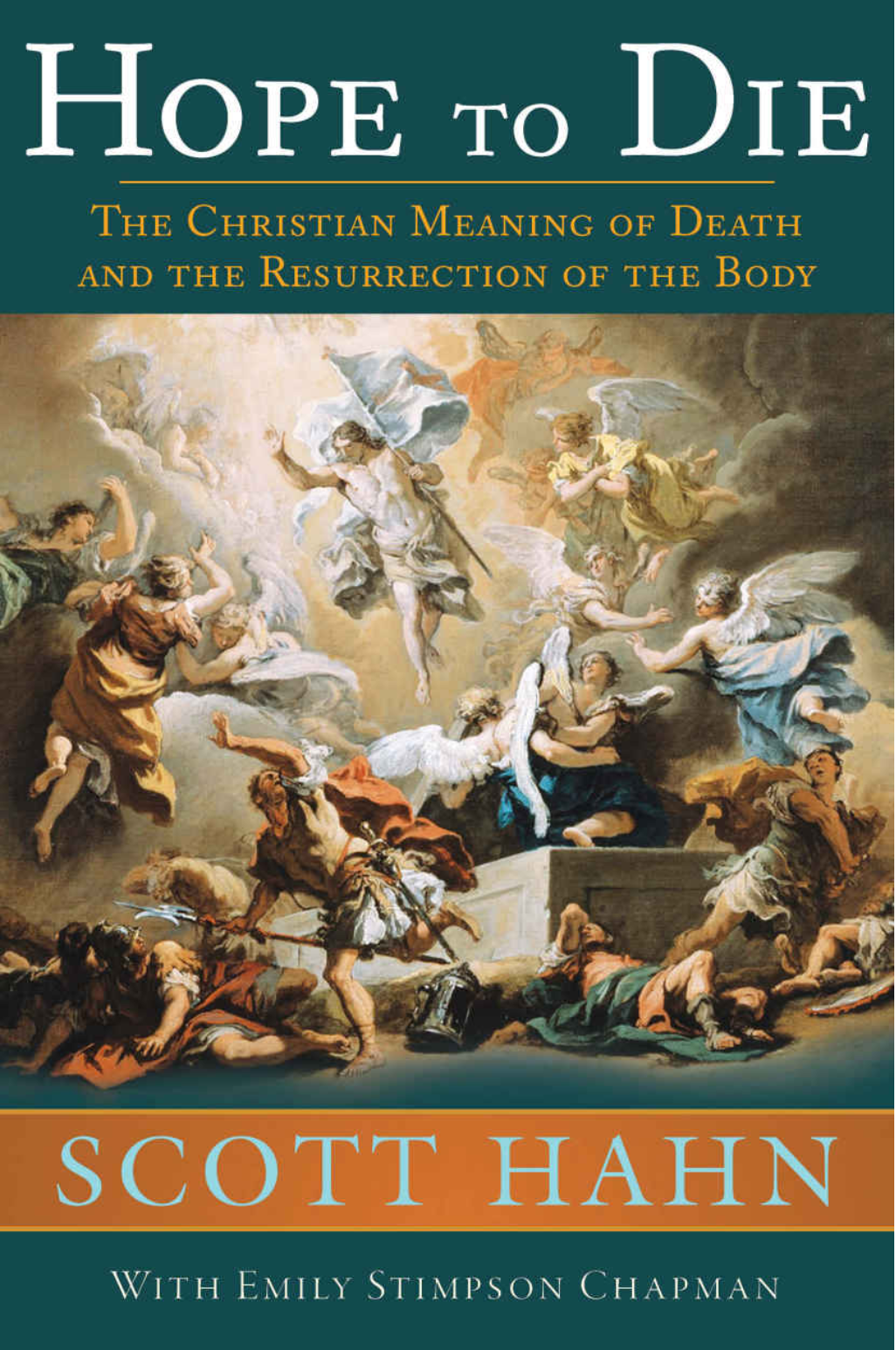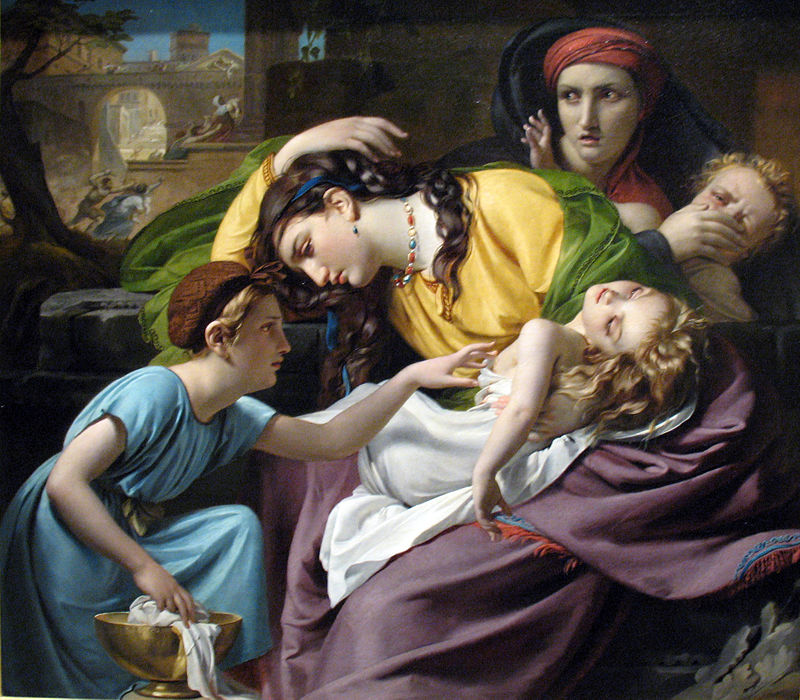
-by François-Joseph Navez, The Massacre of the Innocents (1824), please click on the image for greater detail.
“Prior to April 2007, many Catholics had probably never heard of the International Theological Commission (ITC), a group of thirty theologians from around the world chosen by the Pope as a kind of advisory committee. But the most recent document by the ITC, published with papal approval on April 19, 2007, got a lot of attention—as well it should. Its subject is a tender one: “The Hope of Salvation for Infants Who Die Without Being Baptized.” To Catholic parents who have lost a child to miscarriage, stillbirth, Sudden Infant Death Syndrome, or some other tragedy prior to baptism, such hope is a healing balm for a wounded heart.
Interest in this recent document is understandable, and most people have learned of it through the news media. While many articles written since the document’s publication summarize its contents accurately, many do not. A Google news search reveals headlines such as, “Pope Changes Church Teaching on Limbo,” and “The Church Abandons Limbo.” Such headlines can easily give the impression that 1) Limbo was a defined doctrine of the Church, and 2) the Pope has the authority to change—even to reverse—defined doctrine. A May 4 Washington Post article by Alan Cooperman included the statement “limbo is a ‘problematic’ concept that Catholics are free to reject.”
Beyond the headlines you encounter even larger problems. An April 21 Associated Press article by Nicole Winfield quotes Fr. Richard McBrien (professor of theology at Notre Dame and noted dissenter) as saying, “If there’s no limbo and we’re not going to revert to St. Augustine’s teaching that unbaptized infants go to hell, we’re left with only one option, namely, that everyone is born in the state of grace . . . Baptism does not exist to wipe away the ‘stain’ of original sin, but to initiate one into the Church.” On the other end of the spectrum, Kenneth Wolfe, columnist for The Remnant, was quoted in Cooperman’s article as saying, “The Vatican is suggesting that salvation is possible without baptism. That is heresy.”
These characterizations notwithstanding, the ITC makes no rulings (and does not have the authority to do so). “The Hope of Salvation” in fact reiterates and builds upon the Catholic tradition. It neither categorically rejects Limbo nor denies the necessity of baptism. Rather, it offers reasons to hope that God may provide a way of salvation to those little ones whose lives ended before baptism was possible.
Augustine: No Middle Ground
Debate regarding the fate of infants who die before baptism dates back to the late fourth century, and the famous conflict between Pelagius and St. Augustine. Pelagius asserted that man is capable of living a perfect moral life by virtue of his natural reason and will alone and is not wounded by original sin.
In opposition to Pelagius, St. Augustine successfully defended the reality of original sin using Scripture and the Tradition of the Church. The Apostolic practice of infant baptism was evidence of the Church’s belief that even these youngest ones stood in need of a Savior. Without original sin, baptism could only affect the forgiveness of our personal sins. Infant baptism makes no sense without original sin. In his teaching against the Pelagian heresy, Augustine affirmed the necessity of this ancient practice. If an infant died unbaptized, he died in a state of sin, and was therefore destined to eternal damnation. He denied the existence, “between damnation and the kingdom of heaven [of] some middle place of rest and happiness . . . For this is what the heresy of Pelagius promised them” (On the Soul and its Origin 1.9).
Augustine’s position is not quite as harsh as it seems. In Contra Julianum 5.11, he writes, “Who can doubt that non-baptized infants, having only original sin and no burden of personal sins, will suffer the lightest condemnation of all? I cannot define the amount and kind of their punishment, but I dare not say it were better for them never to have existed than to exist there” (qtd. in John Randolph Willis, The Teachings of the Church Fathers, 245).
Aquinas: Privation, not Punishment
Later theologians developed Augustine’s thoughts, defining damnation as essentially the deprivation of the Beatific Vision, which does not necessarily involve any positive punishment. Distinctions were made between the pain of sense, describing the torments suffered by condemned sinners, and the pain of loss, which is sorrow over being absent from God’s presence.
By the thirteenth century, the dominant view was that unbaptized infants would suffer only the pain of loss. In 1201 Pope Innocent III expressed this opinion in a letter to the archbishop of Arles. Actual sin, the Holy Father asserted, is punished by the eternal torment of hell; original sin, however, is punished by the loss of the vision of God.
This line of thinking was explored thoroughly by St. Thomas Aquinas. The Angelic Doctor consigned infants who died without baptism to the outermost borders of hell, which he called the “limbo of children.” They died without the grace of God, and would spend eternity without it, but they were not worthy of punishment. St. Thomas insisted that these little ones would know no pain or remorse. He explained this opinion in various ways. In his commentary on Peter Lombard’s Sentences, he stated that no one regrets the lack of something which he is totally unequipped to have (II Sent. , d.33, q.2, a.2). Ten years later (in De Malo, q.5, a.3) he suggested that infants would not be distraught over their loss because they simply would have no knowledge of what they were missing.
Eventually limbo ceased to be spoken of as a “border region” of hell. Hell came to be understood as a place of punishment. Limbo was not. And since it has never been a defined dogma of the Church, various theologians have understood limbo in different ways. Most views, however, would include these common characteristics: Unbaptized infants die in a state of sin and enter neither heaven nor hell but limbo, which is a state of damnation not involving pain of sense or grief of exile; indeed, a measure of natural happiness is possible, with some suggesting that the denizens of limbo enjoy a perfect state of natural happiness.
Trust in the Mercy of God
Although limbo has long been the prevailing theory, some theologians have imagined ways in which God may provide for the salvation of unbaptized infants. St. Gregory of Nyssa, in the fourth century, called the fate of these souls “something much greater than the human mind can g.asp” and found solace in the fact that “the One who has done everything well, with wisdom, is able to bring good out of evil” (qtd. in HS 12).
Cardinal Cajetan, in the sixteenth century, remarked in his commentary on the Summa Theologica (III:68:11), “that children still within the womb of their mother are able to be saved . . . through the sacrament of baptism that is received, not in reality, but in the desire of the parents.” In our own times, Cardinal Ratzinger echoed Cajetan in a 1985 interview with Vittorio Messori. “One should not hesitate to give up the idea of ‘limbo’ if need be,” the future pontiff advised. “[A]nd it is worth noting that the very theologians who proposed ‘limbo’ also said that parents could spare the child limbo by desiring its baptism and through prayer” (The Ratzinger Report 147-8).
None of these positions has been officially proclaimed by the Magisterium. Catholics are free to have varying opinions on this matter. Our present Catechism makes no mention of limbo at all, but has this to say regarding infants who die without baptism:
“The Church can only entrust them to the mercy of God, as she does in her funeral rites for them. Indeed, the great mercy of God who desires that all men should be saved, and Jesus’ tenderness toward children which caused him to say: “Let the children come to me, do not hinder them,” allows us to hope that there is a way of salvation for children who have died without baptism. (CCC 1261)”
The Ordo Exsequiarum (Order of Christian Funerals) contains a special rite for children who die before baptism, during which the child’s soul is entrusted “to the abundant mercy of God, that our beloved child may find a home in his kingdom.” Option D of the opening prayer begins, “God of all consolation, searcher of mind and heart, the faith of these parents . . . is known to you. Comfort them with the knowledge that the child for whom they grieve is entrusted now to your loving care.” In the Prayer of Commendation B, the priest says, “We pray that you give [the child] happiness for ever.”
Lex orandi, lex credendi: As we pray, so we believe.
ITC: Reasons for Prayerful Hope
The default position of the Church then, as expressed in her liturgy, is that of hope. “Hope of Salvation” begins with a reference to 1 Peter 3:15: “Always be prepared to make a defense to any one who calls you to account for the hope that is in you . . .” This, in essence, is the purpose of the ITC document.
It is worth noting at this point that “Hope of Salvation” is not a Magisterial document. It does not require the assent of the faithful, as would a proclamation from a pope or an ecumenical council. It simply expresses the opinion of a respected group of theologians. The fact that Benedict XVI has given it his approval and has decided to publish it publicly gives some weight to the conclusions drawn by the commission. But those conclusions are not dogmatic.
In an interview published by Inside the Vatican.com on April 27, Sr. Sara Butler, one of the authors of the document, said,
“The commission is trying to say what the Catechism . . . has already said: that we have a right to hope that God will find a way to offer the grace of Christ to infants who have no opportunity for making a personal choice with regard to their salvation. It’s trying to provide a theological rationale for what has already been proposed in several magisterial documents since the Council.”
The first part of “Hope of Salvation” gives a history of Catholic teaching on this subject, and examines the key principles involved, namely: God’s will to save all people; the universal sinfulness of human beings; and the necessity of faith for salvation, along with baptism and the Eucharist (HS 9). After thoroughly examining the issues, the ITC suggests three means by which unbaptized infants who die may be united to Christ (this is not intended to be exhaustive):
- “Broadly, we may discern in those infants who themselves suffer and die a saving conformity to Christ in his own death and a companionship with him” (HS 85).
- “Some of the infants who suffer and die do so as victims of violence. In their case we may readily refer to the example of the Holy Innocents and discern an analogy in the case of these infants to the baptism of blood which brings salvation . . . Moreover, they are in solidarity with the Christ, who said: ‘Truly, I say to you, as you did it to one of the least of these my brethren, you did it to me’ (Matt. 25:40)” (HS 86).
- “It is also possible that God simply acts to give the gift of salvation to unbaptized infants by analogy with the gift of salvation given sacramentally to baptized infants” (HS 87). “God’s power is not restricted to the sacraments” (HS 82).
These are simply some possible ways, proposed by the ITC, in which we may imagine God offering salvation to these little children. There are others. The commission mentions the possibility of baptism of desire (in votum), with the votum offered either by the infant’s parents or the Church. “The Church has never ruled out such a solution,” we are reminded (HS 94).
No Certainties
But while offering these possibilities to us, the commission is careful not to overstep the bounds of Revelation. “It must be clearly acknowledged that the Church does not have sure knowledge about the salvation of unbaptized infants who die . . . [T]he destiny of the generality of infants who die without baptism has not been revealed to us, and the Church teaches and judges only with regard to what has been revealed” (HS 79).
There are some things that have most assuredly been revealed, and these articles of faith must be considered. Original sin is one of them. When contemplating the fate of unbaptized infants who die, one “cannot ignore the tragic consequences of original sin. Original sin implies a state of separation from Christ, and that excludes the possibility of the vision of God for those who die in that state” (HS 3).
“Hope of Salvation” in many places affirms the reality of original sin and the necessity of baptism. “Sacramental baptism is necessary because it is the ordinary means through which a person shares the beneficial affects of Jesus’ death and resurrection” (HS 10). The key phrase is “ordinary means.” In cases of urgency or necessity, God often provides extraordinary means to accomplish his will. Though water baptism is the ordinary means by which God transmits sanctifying grace, the Church teaches that there are other ways. The realities of baptism of blood and baptism of desire are affirmed by the Catechism (CCC 1258). Citing Gaudium et Spes, the Catechism also explains that “Every man who is ignorant of the Gospel of Christ and of his Church, but seeks the truth and does the will of God in accordance with his understanding of it, can be saved” (CCC 1260). It is in this same context that the Catechism offers us the “hope that there is a way of salvation for children who have died without baptism” (CCC 1261).
None of this, however, can be understood to imply that baptism is not necessary, for the Catechism states, “The Church does not know of any means other than baptism that assures entry into eternal beatitude . . . God has bound salvation to the sacrament of baptism, but he himself is not bound by his sacrament” (CCC 1257).
The necessity of baptism is echoed by the ITC. “What has been revealed to us is that the ordinary way of salvation is by the sacrament of baptism. None of the above considerations should be taken as qualifying the necessity of baptism or justifying delay in administering the sacrament” (HS 103). Sr. Butler, in the above-cited interview, puts it bluntly. “If somebody like Fr. Richard McBrien supposes that the ITC document rejects the doctrine of original sin, this is of course a mistake.” Elsewhere in the interview, she comments, “[W]e dare to hope that these infants will be saved by some extra-sacramental gift of Christ . . . We are very clear that the ordinary means of salvation is baptism, and that infants should be baptized; Catholic parents have a serious obligation.”
The conclusions of the ITC are nothing new. The Catechism tells us that it is reasonable to hope that God provides a way of salvation for infants who die without being baptized. It is a hope rooted in Christ, who instructed that we must be like children to enter the kingdom of God and said, “Let the children come to me” (Mark 10:14-15). “Hope of Salvation” simply provides possible theological reasons for this hope. The ITC readily admits that “these are reasons for prayerful hope, rather than grounds for sure knowledge” (HS 102).
What we do know for certain is this: God has a plan. God is perfectly just and perfectly merciful. God is love. We can rest assured that whatever plan God has established for infants who die without baptism, it is more just, more merciful, and more loving than whatever we may imagine, not less.
Hope for Our Simon
It was a Tuesday afternoon in May. I was home from work, watching our three small children while my wife, fifteen weeks pregnant, went for a scheduled doctor’s appointment, then to do some grocery shopping without the kids in tow. I assumed she would be gone for a while, so I was surprised to see her pull into the driveway earlier than expected. As I walked down the driveway to help her bring in the groceries, her gaze met mine. I knew from one look that something was wrong. Really wrong.
She started to cry, so I put my arms around her. That’s when she told me. “They can’t find a heartbeat.” The next several hours were a blur. Lots of tears. Phone calls to our parents. Talking to our kids. More tears. The trip to the hospital. One more ultrasound, just to be sure. The inducement of labor. Lots of prayers. And the final delivery of our small son, whom we named Simon. His umbilical cord had been wrapped multiple times around his neck, depriving his brain of oxygen. “It just sometimes happens,” the nursing staff told us.
We are blessed to have as our pastor a very orthodox and very compassionate priest. He came to the hospital and prayed with us. The doctor who delivered our other children, also a devout Catholic, prayed with us, as well. Of course the subject of baptism came up. There was simply nothing we could do. But I desperately wanted baptism for my son. What bothered me the most about his untimely death was that I never had the opportunity to bring him into the faith, to provide for his salvation.
I knew my catechism. I knew that the Church simply didn’t know what the fate of children like Simon would be. Perhaps because of this, I quickly grew tired of the assurances offered as attempts at consolation. “He’s in heaven now,” we were told by well meaning friends. Sentiments like that rang empty. How can you be so sure of that, I thought, when the Church herself has no such assurances? I cringed whenever I was told that “God needed another angel.” God needs nothing outside of himself. And wherever he is in eternity, my son is a human being, not an angel.
Simon’s funeral Mass was held on that Friday. It was a small service, attended by family and a few friends. Our priest gave a very comforting homily, and he ended by sharing with us that he had been praying his Liturgy of the Hours immediately before the funeral. The antiphon for the midmorning reading that day happened to be adapted from Luke 24:34: “The Lord is risen, alleluia. He has appeared to Simon, alleluia.”
Of course those words were not written in reference to our Simon. Nevertheless, my heart leapt in my chest when I heard them. For our priest expressed the prayer that Christ would somehow make himself present to our little son, in a way known only to him. This is the position of the International Theological Commission: that it is reasonable to “hope that God will save infants when we have not been able to do for them what we would have wished to do, namely, to baptize them into the faith and life of the Church” (HS 103).
Our pastor offered no empty assurances. No, he gave us something much greater than that. He gave us hope.
An Excerpt from “The Hope of Salvation for Infants Who Die Without Being Baptized”
“The idea of limbo, which the Church has used for many centuries to designate the destiny of infants who die without baptism, has no clear foundation in revelation even though it has long been used in traditional theological teaching. Moreover, the notion that infants who die without baptism are deprived of the beatific vision, which has for so long been regarded as the common doctrine of the Church, gives rise to numerous pastoral problems, so much so that many pastors of souls have asked for a deeper reflection on the ways of salvation.
The necessary reconsideration of the theological issues cannot ignore the tragic consequences of original sin. Original sin implies a state of separation from Christ, and that excludes the possibility of the vision of God for those who die in that state . . .
However, with regard to the salvation of those who die without baptism, the word of God says little or nothing. It is therefore necessary to interpret the reticence of Scripture on this issue in the light of texts concerning the universal plan of salvation and the ways of salvation. In short, the problem both for theology and for pastoral care is how to safeguard and reconcile two sets of biblical affirmations: those concerning God’s universal salvific will (cf. 1 Tim. 2:4) and those regarding the necessity of baptism as the way of being freed from sin and conformed to Christ (cf. Mark 16:16; Matt. 28:18-19).
. . . [W]hile knowing that the normal way to achieve salvation in Christ is by Baptism in re, the Church hopes that there may be other ways to achieve the same end. Because, by his Incarnation, the Son of God “in a certain way united himself” with every human being, and because Christ died for all and all are in fact “called to one and the same destiny, which is divine,” the Church believes that “the Holy Spirit offers to all the possibility of being made partners, in a way known to God, in the paschal mystery.”
Love, & the glorious mystery of God’s love for each of us,
Matthew
